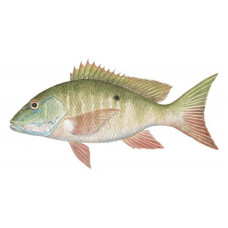Latin name
Lutjanus analis
Other names
Portuguese: cioba; Spanish: pargo cebalo, pargo cebal, pargo colorado, pargo criollo, pargo mulato.
Identification
Body is moderately high. Head is pointed. There are fang-like teeth on both jaws. There are teeth on the caterpillar. The bases of the soft part of the dorsal and anal fins are covered with scales. The anal fin is pointed. The appearance can be very bright: orange to reddish yellow or reddish brown, or silvery gray to olive green on the back and upper flanks. All fins below the lateral line have a reddish hue, and larger individuals take on an overall reddish color. Young fish are often olive-colored and may have dark streaks. There is a distinct black spot about the size of an eye on the midline of the body below the posterior dorsal fin. In addition, there are small blue lines under and near each eye, and the dorsal fin has 10 spines and 14 rays. Adults usually have a high back.
Distribution
In the western Atlantic, common from Massachusetts to southeastern Brazil, including the Caribbean Sea and the northern Gulf of Mexico. They are most abundant off the Antilles, the Bahamas, and off southern Florida, and have been introduced into the waters of Bermuda.
Habitat
Sea-bottom fish of coastal waters. Juvenile fish live on the soft bottom, in seagrass beds, and adults live on the hard bottom around rocky and coral reefs and in bays and estuaries. They drift above the bottom at depths of 5 to 60 feet.
Size
Length up to 80 cm and weight up to 15 kg. It has a high rate of growth: off the coast of Cuba, at the age of 1 year its average length is 32 cm, 2 years - 42 cm, 3 years - 55 cm, 4 years - 60 cm and 5 years - 61 cm. Becomes sexually mature at 40 cm in length and 1.7-1.8 kg in weight. Usual length of 1-2 feet and 15 pounds, can reach a weight of 25-30 pounds and a length of 30 inches. The world record among all tackle is considered to be a Florida fish weighing 30 pounds 4 ounces.
Life history and Behavior
Spawning occurs from May to October, with peak activity in July and August. Mutton snapper form small groups that disperse into the current at night.
Food and feeding habits
Feeding day and night mainly crustaceans, as well as shrimp, fish, snails, crabs, and plankton.
Reproduction
Off the coast of Cuba, spawning occurs in March-October, peaking in May-June. Near the southern tip of the Florida Peninsula, spawning occurs in July-August. In the northeastern part of the Caribbean Sea, spawning occurs in February.
| Classification | |
| Phylum | Chordata |
| Class | Actinopterygii |
| Squad | Perciformes |
| Family | Lutjanidae |
| Genus | Lutjanus |
| Species | L. analis |
| Features | |
| Conservation status | Near Threatened |
| Habitat | Littoral |
| Life span, years | No information |
| Maximum body weight, kg | 15.6 |
| Maximum length, cm | 94 |
| Sailing speed, m/s | No information |
| Threat to people | Edible |
| Way of eating | Predator |


